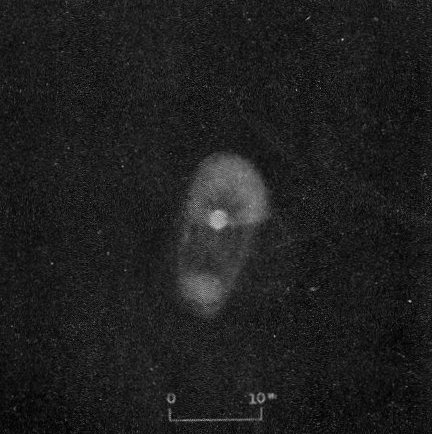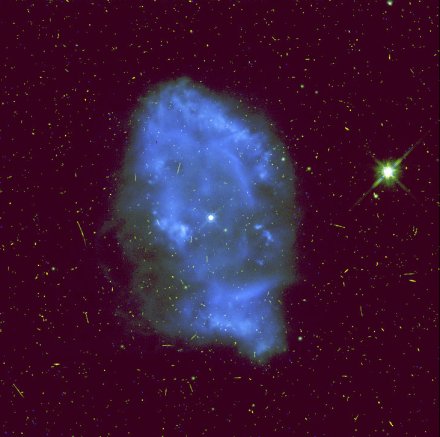NGC 6309
Located in the eastern path of the Milky Way
in southern Ophiuchus 3 degrees north-
northeast of Eta Ophiuchi (Sabik), and not
all that far from the center of the Galaxy, lies NGC 6309. Small and
compact, the telescope readily reveals a complex elliptical
structure 19 X 10 seconds of arc across. Curtis says of it: "fairly
bright" and "quite irregular" with a "southern condensation." The
Hubble image displays what appear to be nested shells with the same
"condensation" (rotate the Hubble image about 30 degrees clockwise
to bring the two into the same orientation, with north to the top).
Called "bipolar" for the two bright lobes, NGC 6309 is actually
more quadripolar. Surrounding the compact object seen here is an
outer shell more than three times as large, which probably
represents earlier stages of mass loss. Measures of distance are
all over the place, but center on about 7000 light years, a value
that should not be taken very seriously. If at that distance, the
inner object averages just over half a light year across, while the
diameter of the outer shell (invisible here) is around two light
years, half the distance between the Sun and Alpha Centauri. The inner shell expands at about 20
to 40 kilometers per second, increasing outward. Intervening
interstellar dust, which fills the Milky Way, dims the object at
visual wavelengths by around two magnitudes.
Curtis gives a visual magnitude for the central star of 13. Modern
measures come close at 13.7, from which (and the brightness of the
nebula, which gives the amount of ultraviolet radiated by the
star) we derive a stellar temperature of around 90,000 Kelvin and
a total (very uncertain) luminosity of about 1800 times that of the
Sun. Together they suggest a low core mass of around 0.55 Suns and
that the star is still heating, but will shortly begin to cool and
dim to become a white
dwarf of about the same mass).
Left: Image by H. D. Curtis from Publications of the Lick
Observatory, Volume 13, Part III, 1918. Right: H. Razizadeh and
the ESA/ESO/NASA Photoshop FITS Liberator.



